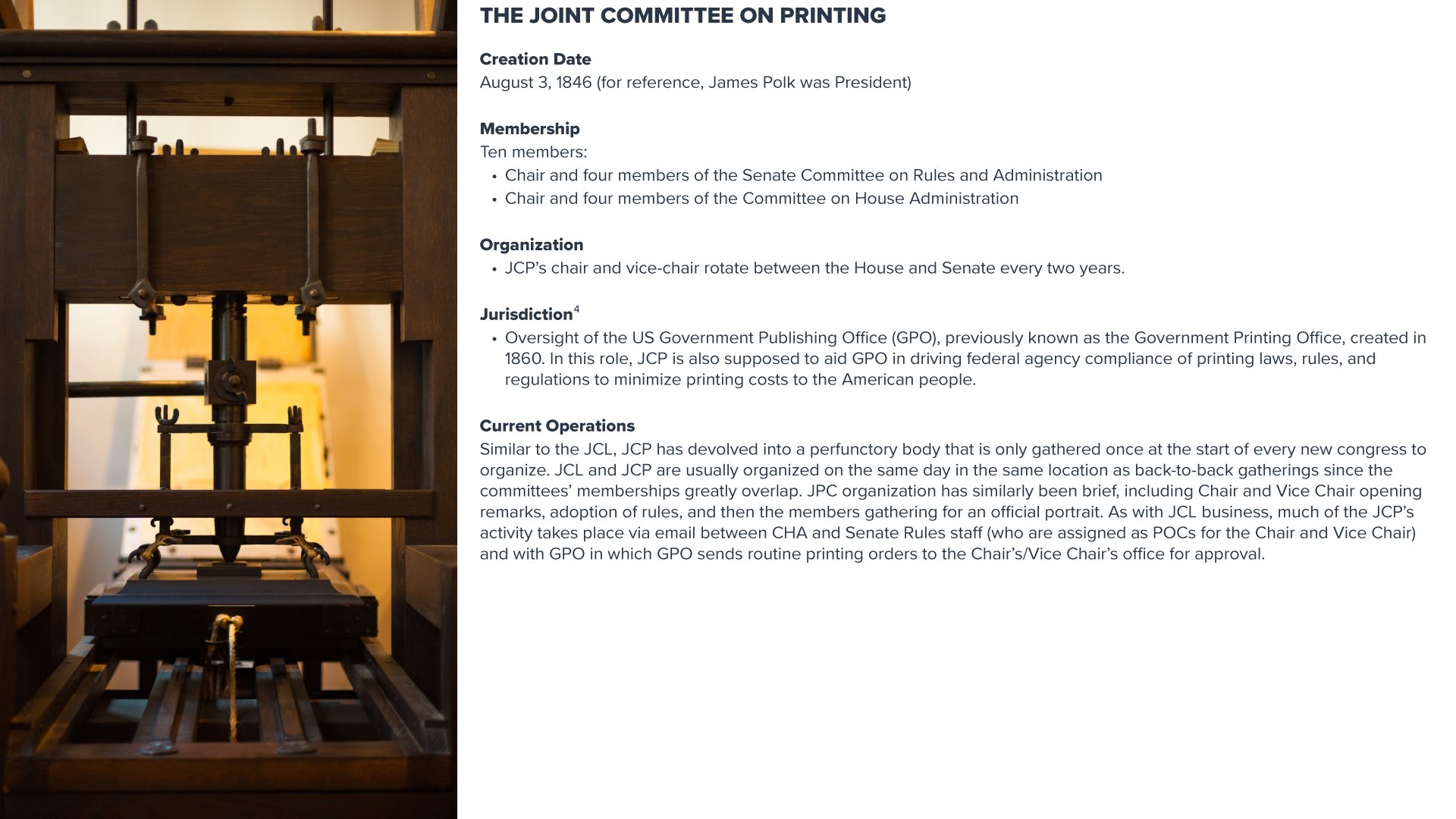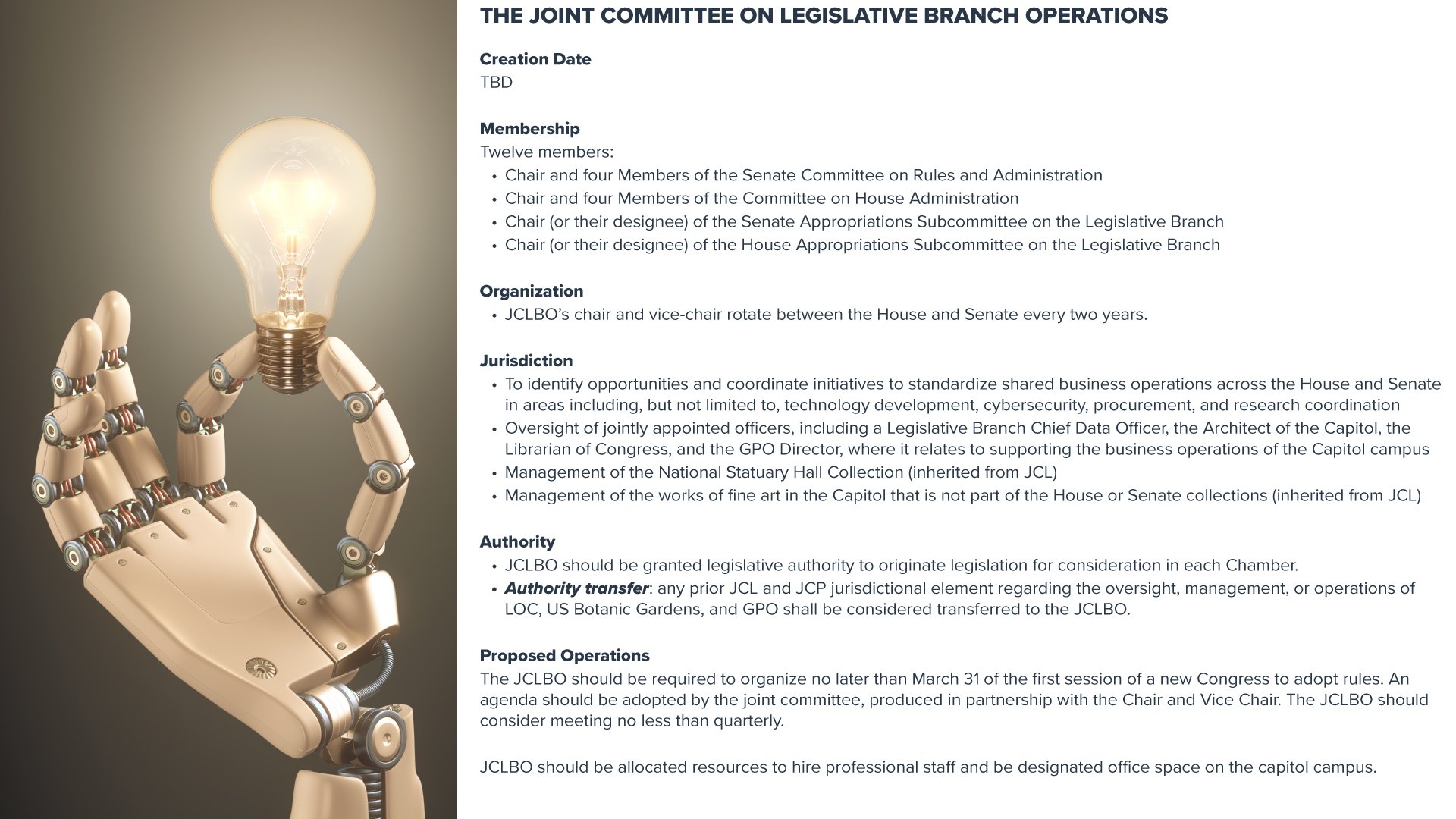Reviving Leadership Over the Legislative Branch: A Proposal for a Joint Committee on Operations
BY AUBREY WILSON
The Legislative branch is more than the House of Representatives and the Senate. With approximately 20,000 staff spread across two political bodies, five major agencies, and at least a dozen support and independent offices, the Legislative branch is continually called upon to have clear, efficient processes through which to set policies and provide oversight concerning its operations.
Two key functions the House and Senate have co-managed since the 1800s are Congressional printing and research, which both chambers formalized their oversight jurisdiction of through the creation of the Joint Committee on the Library (JCL) and Joint Committee on Printing (JCP), founded in 1802 and 1846 respectively. (Other functions have been managed in bespoke ways, such as the Budget Committee’s Oversight of Congressional Budget Office (CBO), House Oversight and Senate HSGAC’s Oversight of Government Accountability Office (GAO), Capitol security through the US Capitol Police Board, and so on.) However, unlike these other entities’ oversight bodies, JCL and JCP have become at best perfunctory, at worst futile. These two-century-old bicameral clubs that once played a key role in increasing the public’s access to government information have been stripped of their resources and all sense of purpose, creating significant gaps with respect to bicameral oversight of essential elements of the Legislative branch’s operations.
The 1800’s Best Intentions
The JCL and JCP are the two oldest and long-standing joint committees of Congress. Although these joint committees played a vital role in the House and Senate’s coordinated organization and oversight of the Library of Congress and the printing of public documents for generations, their powers were severely curtailed in the 1990s.
Due to legislative reorganization under new House leadership, the chambers defunded JCP’s and JCL’s ability to hire dedicated staff and devolved many of their responsibilities to separate standing committees of which their roster was built from, the Committee on House Administration and Senate Committee on Rules and Administration.
In the thirty years since, JCP and JCL exist mostly in name. Organized in the first session of every new Congress, Members appointed to be part of these legacy joint committees gather during an afternoon to gavel in, adopt rules, take a picture, and gavel out, not to formally meet again until this checking-the-box exercise is needed again. In the meantime, there remains a significant need for these Representatives and Senators to gather around one dais and drive a unified agenda for Legislative branch operations.
Congress is in need of a bicameral coordinating function to assert its oversight authority and proactively provide direction to entities within the Legislative branch. Although the jurisdiction of the longstanding JCL and JCP are no longer directly relevant, there are vital, modern operational functions and institutional authorities yearning for a joint committee to address. The JCL and JCP can be evolved to meet the modern Congress’s needs as one Joint Committee on Legislative Branch Operations (JCLBO).
Upgrading Tradition: Empowering a Joint Committee on Legislative Branch Operations
Although they are two halves of one legislature and their chambers reside in the same building, numerous operational elements are siloed and duplicated across the House and Senate. Technology development, contract procurement, cybersecurity guidance and standards, and even employee contact information is undertaken and managed by each chamber independently. This lack of coordination, which evolved ad hoc over generations of institutional growth and maturity, has resulted in duplicity, waste, inefficiencies, and a host of information sharing and resource allocation issues. The issues only continue to mount. Two recent examples showcase the impact of the chambers’ disparate approaches specific to technology modernization.
The first is addressing the need for a shared e-signature platform during the COVID pandemic. In response to remote work required during this time, the House Clerk and Secretary of the Senate authorized use of electronic signatures for legislative items and official letters. Due to data security, the Senate Sergeant at Arms developed an e-signature platform internally called Quill that, to this day, is owned and maintained by the Senate. The House, experiencing the same demand for this technology but not wanting to duplicate the Senate’s development work, contracted with the Senate to use Quill, launching House member and staff access in May 2021. However, there are key formatting differences between the chambers’ legislative documents that require addressing by Quill’s developers to lead to future optimization of the platform by the House. Unfortunately, these House requests are not prioritized by Senate IT designers, since the House is not Quill’s first customer (the Senate is). Quill is a great example of a tool that should have been developed co-equally by a team resourced from both chambers, resulting in a tool that is co-owned and equally utilized by each.
A second example is the House’s and Senate’s individualistic approaches to setting guidance around the internal use of generative artificial intelligence (GenAI) powered commercially available large language models (LLMs), such as ChatGPT. With the emergence of this new technology in fall 2022, both chambers undertook separate risk assessments of the tools available in the marketplace. In June 2023, the House’s Chief Administrative Office’s House Information Resources (CAO HIR) team issued House-wide guidance authorizing sole use of ChatGPT, restricted to research and evaluation tasks only. Five months later, the Senate issued its own guidance which, unlike its peer’s guidance, allows for staff and member use of Google’s Bard AI and Microsoft’s Bing AI Chat in addition to ChatGPT. This disparate guidance surrounding the secure and appropriate use of cutting edge technologies on official devices that are issued to all Congressional staff and elected officials is confounding and frustrating. How can one legislature not have better coordination and shared cybersecurity guidance?
The JCL and JCP were not failed models, rather they were undercut by the politics of their time and no longer function as they were intended. Their long legacy and continued existence demonstrates how rare — and yet necessary — a bicameral Member organization is to ensure that the House and Senate advance in a synchronized way, particularly regarding infrastructure and business operations. The Committee on House Administration and Senate Committee on Rules and Administration are effective entities in their own right, housed within their separate chambers. However, bringing representatives from these two bodies together to foster cross-chamber coordination is far beyond due; it is necessary for the modern Congress. A revitalization of the JCP and JCL as one Joint Committee on Legislative Branch Operations can not only cement the legacy of these foundational joint committees, but re-empower the House and Senate to sit around one dais to steer the Legislative branch’s business functions as one institution. Congress should explore this approach by re-engaging with individuals who previously staffed the JCP and JCL prior to their resource cuts in the 1990s, propose the official creation of a JCLBO, and empower this new joint committee with a dedicated staff, budget, and revived jurisdictional authority.
Background and Current Structure



